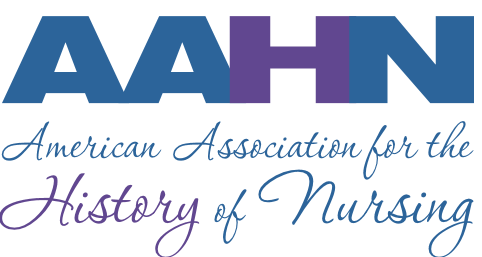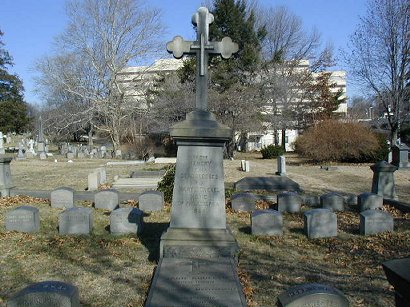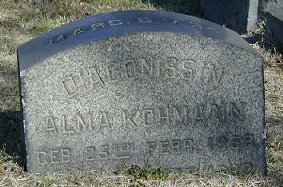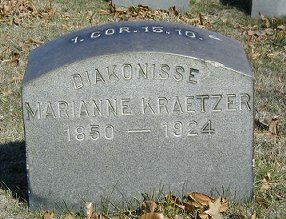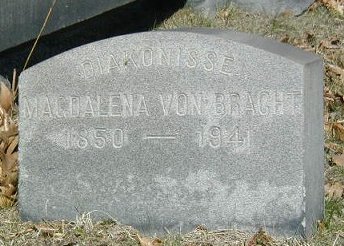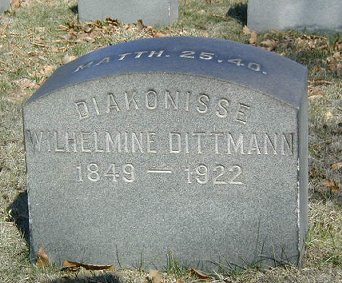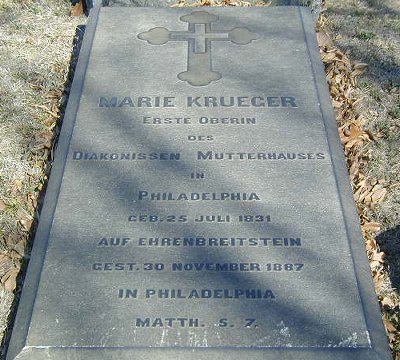The deaconesses are buried in Philadelphia's historic Woodlands Cemetery
in what is known as the "Nurses Corner"
A small group of dedicated women who traveled from Germany to Philadelphia in 1884 became the first nursing deaconness in the United States. Although this group was not all trained at Kaiserworth they provided a direct link to a protestant nursing model that had influenced Nightingale (D'Antonio). During the mid 1800's, there was a large German population in the city of Philadelphia which discussed plans for a hospital in which Germans could be treated by German doctors and nurses (Henry, 1909). In 1860, a Board of Trustees was created and they mandated that German Hospital would care for all people, not just Germans. In 1861, with the help of the Ladies Aid Society, the Board of Trustees purchased Penn Brook, the home of Will Norris (Henry, 1909).
German Hospital began as a United States government treatment center during the Civil War (West, 1926). On November 29, 1866, German Hospital opened its doors to the public. A major change occurred in 1869 that would forever change the future of German hospital: John D. Lankenau, a famous trustee of the hospital, becames president; it was under his direction and leadership that helped transform German Hospital into the health facility that it is today. German hospital was reneamed Lankenau Hospital in 1917.
The original mission of the hospital was to provide Germans with health care provided by German-speaking doctors and nurses. Close ties were maintained with Germany, and the physicians at German Hospital often put medical advances made there into practice in Philadelphia. In 1884, upon the request from the German Hospital, seven Lutheran deaconesses were asked to come to America to work in the hospital.
Sister Magdalene von Bracht, Sister Wilhilmine Dittman, Sister Alma Kohlmann, Sister Marianna Kraetzer, Sister Pauline Loeschman, and Sister Frederike Wurzler were lead by Sister Maria Krueger, who was the oberin (directing sister), to come to the German Hospital to not only work there, but in several outposts in the area (Lutheran Deaconess Association, 1974). These women played a key role in the creation of the Mother House in Gladwyne, PA, attracting more deaconesses to come to Philadelphia and the surrounding area. By 1889 there were 25 sisters in the area and in 1894 the number had grown to 39 in various places around Philadelphia (Lutheran Deaconess Association, 1974).
During their early years in Philadelphia, the deaconesses faced many challenges. Within the first few months, Sister Pauline, who was not trained in hospital work, left to live in St. Louis with relatives. Shortly afterward, Sister Frederike who was a very capable surgical nurse, returned to Germany in 1885 due to an illness. But the biggest challenge facing the deaconesses was the death of Sister Marie Krueger. She was their administrator and leader, beloved and respected by all, because it was her who brought them all together and it was her who brought them to America to work (Lutheran Deaconess Association, 1974).
Sister Magdalene Von Bracht worked as a nurse in Philadelphia in 1884 to her death in 1941. Throughout her time in German Hospital, she was not appointed supervisor of the hospital, but was recognized by all of her colleagues as the lady in charge. When she arrived in 1884 she worked only with female patients in the women's ward (Sister Louise Burroughs, 1981). After Sister Marie Kruegers death in 1887, Sister Magdalene was placed in charge until Wanda Von Oetzen arrived from Germany in July of 1888. Wanda Von Oetzen served as supervisor until her death in 1897. Once again, Sister Magdalene Von Bracht was placed in charge, but still not formally as the supervisor of the hospital. Sister Magdalene continued as this unofficial head of the hospital until 1909 when Sister Marie Koeneke replaced her as the head. Ultimately, Sister Magdalene retired at the age of 81, but she still continued to visit patients and to talk to them, always with kind and encouraging words for the ill. On December 29, 1939 prior to her death, the Lutheran Church honored her and celebrated her 70th anniversary of her entering the deaconate (Sister Louise Burroughs, 1981). She died in 1941 at the age of 91.
The other three sisters, Sister Wilhelmine, Sister Marianne, and Sister Alma also worked for German Hospital or other causes related to the Lutheran church until their deaths. Sister Wilhelmine spent her career as a surgical nurse until her death in 1922 (Sister Louise Burroughs, 1981). Sister Marianne was in charge of the kitchen and housekeeping departments within the hospital. In addition, during the summer she supervised the garden and she also served as housemother in Cape May Point. She also served abroad until her death in 1924 at the age of 74. Sister Alma specialized in women's care and worked in the women's ward at the hospital. She also worked in the office of the Aged Home till her death in 1892 at the age of 33 (Sister Louise Burroughs, 1981).
The Spanish American War brought hundreds of American soldiers to German Hospital for care resulting in overwork for the deaconesses (Sister Louise Burroughs, 1981). A need for a larger working force to help them in their daily activities was the impetus for Sister Magdalene's decision to create the school of nursing at German Hospital in 1899.
The School reached peak enrollment during the 1960's and 1970's with an LPN program between 1967-1979. However, with the increasing need for baccalaureate education, admission rates dropped off significantly during the 1980's. To alleviate this decline, the School of Nursing affiliated with Eastern College in Pennsylvania, but admissions and graduated rates still declined. Consequently, the School of Nursing at Lankenau Hospital closed in 1992.
Today, Lankenau Hospital is an important part of health care delivery in the Philadelphia suburbs. With the help of these seven pioneers from Germany, it created the strong foundation of health care that Lankenau Hospital provides today.
Sources:
D'Antonio, P.O. (2003). Information in e-mail.
Henry, F. P. (Ed.). (1909). Founder's Week - Memorial Volume. Philadelphia, PA: F.A. Davis Company. Pioneers... (1974). The Deaconess, 5(1), 1-3.
Sister Louise Burroughs (Ed.). Archives of German Hospital (Vol.). Gladwyne, PA: .
West, R. W. (Ed.). (1926). History of Nursing in Pennsylvania . Philadelphia, PA: Pennsylvania State Nurses Association.
Photos by Mark Concepcion and Edward Chen and may not be used without their permission. Thanks to Mark and Edward and their professor Karen Buhler Wilkerson and Patricia D'Antonio for submitting this feature, which was a class project at the University of Pennsylvania.
